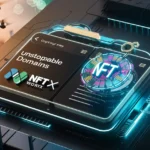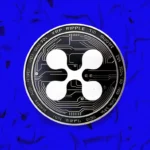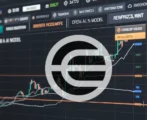Ethereum is the largest altcoin in the cryptocurrency market. Its growth has been phenomenal, as it revolutionized the blockchain space by creating a way for people to have real-life applications atop blockchain.
Despite the iconic growth, many novice traders in the industry still ask, “How does Ethereum work?”
Unlike Bitcoin, whose use case as a digital currency and investment asset is deeply rooted, Ethereum’s dominance is in its blockchain network. The Ethereum blockchain creates decentralized applications (DApps) such as games, finance platforms, and other applications.
In this article, we will dive deep into the Ethereum ecosystem. This article answers the fundamental question that many new crypto traders have: “How does Ethereum work?”
What is Ethereum
Ethereum paves the way for blockchain technology to gain broader adoption in everyday tasks. The network operates as a decentralized global software platform with blockchain technology backing.
Ethereum boasts of smart contracts. These are computer programs that execute actions based on various conditions. As such, Ethereum is not just gaining interest with investors exploring blockchain technology. Instead, it is picking the interest of software developers who want to tap the potential of blockchain to create applications.
The projects created on Ethereum or any other blockchain network are known as decentralized applications. Such projects tap the potential of blockchain technology, such as improved security, better community engagement, efficiency, etc.
We cannot discuss Ethereum without mentioning its native cryptocurrency, Ether (ETH). ETH makes up the Ethereum ecosystem and is used to settle transactions on the platform.
A Brief History of Ethereum
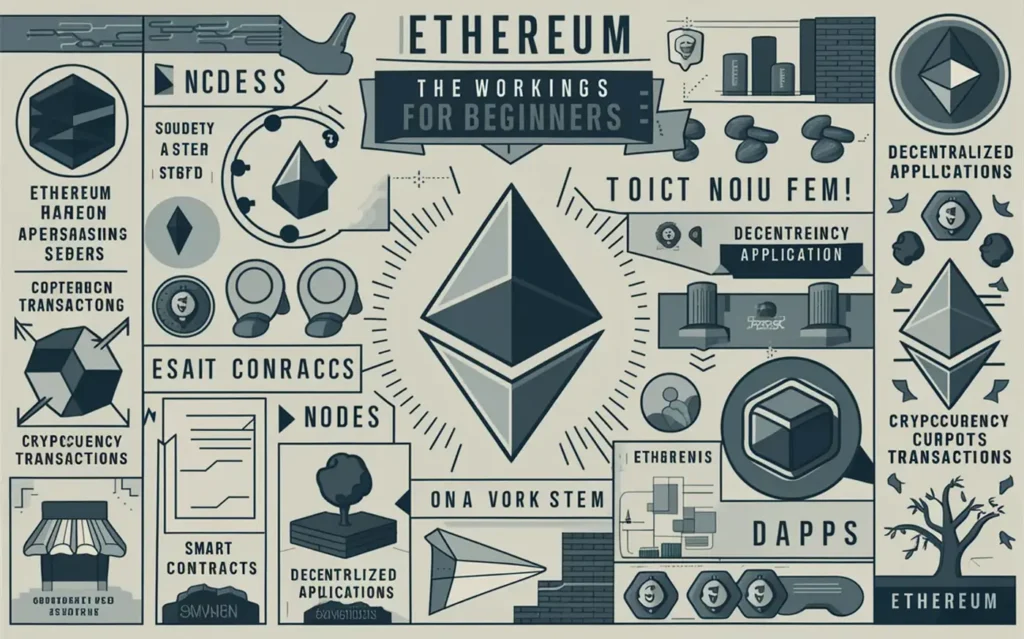
The Ethereum whitepaper was published in 2013, and it detailed the purpose of the blockchain, which was to have a platform to create decentralized applications (DApps). The Ethereum whitepaper outlined the fundamental principles of the network and the potential it had to revolutionize the blockchain industry.
Developers, led by Vitalik Buterin, have been a vital piece of the Ethereum ecosystem. Buterin, alongside others like Joe Lubin, Gavin Wood, Jeffrey Wilcke, and Charles Hoskinson, later announced the start of the Ethereum project in 2014.
Ethereum debuted through an initial coin offering (ICO) in 2014. The team managed to raise more than $18 million, with the funds going towards funding development on the blockchain. Ethereum later conducted its first public release in July 2015.
During its early years, the Ethereum network was plagued with growing concerns about high fees, slow speeds, and inefficiency. These complaints led to the Ethereum Foundation formulating a plan to upgrade the network. The network is now the largest platform for DApps, as seen from DeFiLlama.
Ethereum’s Native Cryptocurrency, Ether
Ether (ETH) is the native cryptocurrency of the Ethereum blockchain. It is also the second-largest cryptocurrency after Bitcoin by market capitalization.
Ether serves multiple roles on the Ethereum blockchain. The first is that it is used to pay gas fees. Any developer looking to create an application on the Ethereum blockchain has to pay ETH to pay for network usage.
ETH also serves a critical role in Ethereum staking. After Ethereum switched to a proof-of-stake (PoS) consensus in 2022, the network required validators to verify transactions. One can stake ETH on the network to become a validator and earn rewards.
The rewards, payable in ETH, depend on the amount of tokens staked and the duration for which they were staked.
If you are looking to obtain Ether tokens, you can do so by purchasing the tokens on a cryptocurrency exchange. You can also participate in staking, become a network validator, and earn rewards in ETH.
Ether, just like any other cryptocurrency, is highly volatile. The price fluctuates periodically and can sometimes post double-digit or triple-digit gains, as seen below.
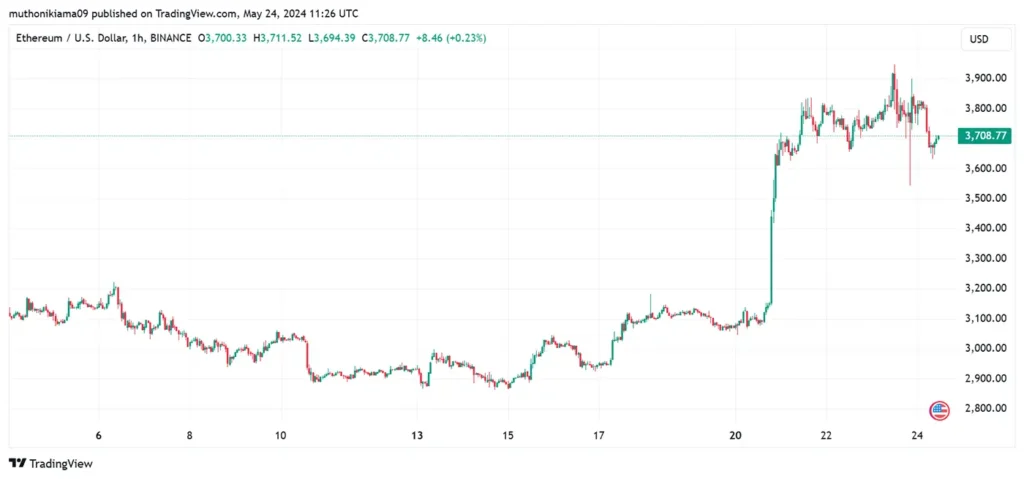
Despite the volatility, Ether is rapidly gaining a use case as an investment option. The US Securities and Exchange Commission (SEC) recently approved spot Ether exchange-traded funds (ETFs), enabling the product to be traded on Wall Street.
How Does Ethereum Work?

To answer the question “How does Ethereum work?” we must discuss the features that make up the Ethereum ecosystem. These features include the following:
Smart Contracts
Smart contracts are autonomous computer programs executing transactions whenever conditions are met. These programs negate the need for intermediaries in the transaction process. They also bring more transparency and security.
The Ethereum blockchain is capable of facilitating smart contracts. These programs allow the blockchain to support decentralized applications (DApps) creation.
By integrating smart contracts, Ethereum differs from the Bitcoin network. The blockchain allows various applications to be created on the network, including games and decentralized finance (DeFi) applications.
Decentralized Applications (DApps)
DApps are the applications that run on blockchain technology. It taps the smart contract capabilities of Ethereum to enable secure, transparent, and immutable data.
Dapps created on Ethereum include DeFi platforms, where financial transactions such as lending and borrowing are brought onchain. DeFi applications claim to be superior to traditional finance as they focus on transparency, efficiency, and immutability.
The rise of DApps on Ethereum has led to the Web3 trend. Web3 is a term describing the applications created using blockchain technology. It proves superior to Web2 technology by giving users more control, speed, and security.
Ethereum Virtual Machine (EVM)
The other feature of “How does Ethereum work?” is the Ethereum Virtual Machine (EVM). The EVM is the environment under which smart contracts run on Ethereum. It promotes decentralization and a consensus-driven operation on the blockchain.
The EVM seeks to improve security and uniformity across the blockchain. The design of this framework plays a crucial role in boosting interoperability. Multiple blockchains have identified the potential of EVM and worked with EVM-compatible layers in their operations.
Smart contracts on Ethereum can also run on the EVM-compatible layers without significant changes. The process trims development efforts while bridging multiple blockchain communities. It also promotes collaboration while growing the DApp landscape.
Ethereum Gas Fees
Ethereum gas fees also play a vital role in the Ethereum ecosystem. Gas fees are a term describing a fee that people pay to use a blockchain network. Whenever someone pays gas fees on Ethereum, they pay for the efforts made by network validators to verify transactions.
Gas fees on the Ethereum blockchain are paid in Ether (ETH), the native token for the Ethereum blockchain. The ETH paid as gas fees are directed to those looking to stake on the Ethereum blockchain and participate in network validation.
Gas fees paid on the Ethereum network by Ethereum users have always been a contentious issue. The fees rise and fall based on the level of activity on the network. The gas fees will increase when the network is in high demand.
Ethereum 2.0

We must look at Ethereum 2.0 and the efforts made by Ethereum developers over the years to make the network more competitive in the rapidly growing cryptocurrency industry to talk about how Ethereum works.
Ethereum 2.0 is also known as Serenity or Eth2. It refers to an upgrade to the Ethereum blockchain to boost network speeds while bolstering scalability and efficiency. Ethereum 2.0 does not refer to a new Ethereum blockchain. Instead, it is an upgraded version of the existing blockchain.
The journey towards Ethereum 2.0 started in 2020 with Beacom Chain. The Beacon Chain upgrade involved creating a proof-of-stake network that runs separately from Ethereum proof-of-work.
In 2022, Beacon Chain merged with the Ethereum mainnet in a process known as The Merge. The Merge saw Ethereum ditch the proof-of-work (PoW) consensus in favor of proof-of-stake (PoS). The Ethereum blockchain abandoned mining and reduced the token’s energy consumption by more than 99%.
Upgrades to the Ethereum blockchain are still ongoing. The latest upgrade was the Dencun upgrade, which went live in March. This upgrade aimed to bring scalability to Ethereum while lowering the transaction fees payable on layer two solutions.
Once all these upgrades are realized, Ethereum will emerge as a top-performing blockchain network. An upgraded Ethereum blockchain will allow the network to compete with rivals like Solana and Avalanche.
How to Buy Ethereum
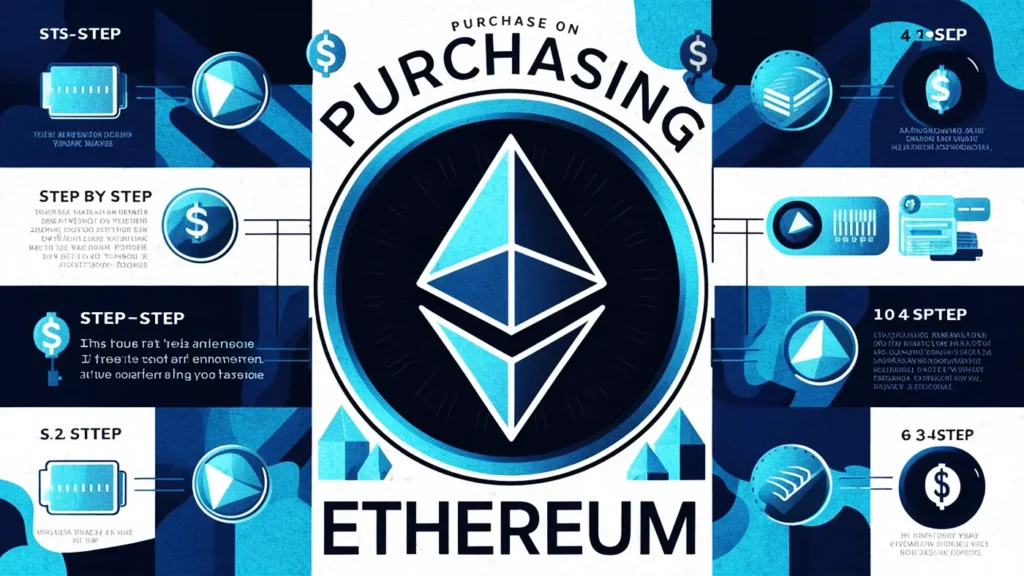
With the question “How does Ethereum work?” answered, the next step is to look at how to buy Ethereum. If you want to buy Ethereum, create a cryptocurrency exchange. After funding your account, place an order and transfer your tokens to either a cold wallet or a hot wallet.
Before you buy Ethereum, it is best that you understand the risks involved. Like any other cryptocurrency, Ethereum is highly volatile. The price can change drastically without notice, exposing you to significant losses.
You do not have to buy Ethereum to participate in the Ethereum ecosystem. You can choose to participate in staking activities. Staking allows you to earn rewards by locking away Ether.
You can also interact with the DApps created on Ethereum to be part of the ecosystem. These DApps allow you to tap the benefits of Ethereum and achieve significant growth.
In Summary: How Does Ethereum work
Ethereum is one of the fastest-growing blockchain networks. This blockchain supports DApps that tap the benefits of blockchain technology. The DApps created on the Ethereum blockchain boast high speed, scalability, and security.
The Ethereum blockchain can potentially transform multiple industries, including gaming, DeFi, social media, and other areas where Web2 applications have failed.
Ether, the native token for the Ethereum blockchain, is used to pay gas fees and settle transactions on the network. The token is rapidly gaining interest as a source of investment following the recent approval of spot Ether ETFs.
FAQs
What are smart contracts on Ethereum?
Smart contracts are self-executing contracts with terms written directly into code. Smart contracts support the creation of DApps.
What is the Ethereum Virtual Machine?
The Ethereum Virtual Machine is a crucial infrastructure to run DApps on the blockchain. The EVM allows anyone to run a program by providing the essential infrastructure to execute DApps and smart contracts.
What are Ethereum gas fees?
Ethereum gas fees are the fees for processing transactions on the network. These fees are paid in the form of Ether (ETH).
What is Ethereum 2.0?
Ethereum 2.0 is an upgrade to the existing Ethereum blockchain. It refers to the improvements made to Ethereum over time to improve speeds and lower transaction fees.





